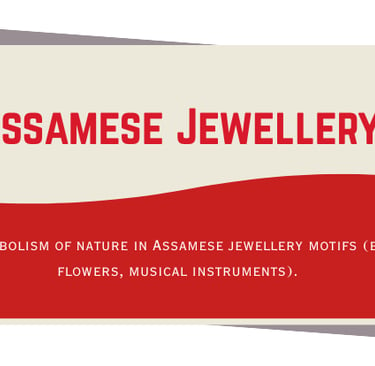The symbolism of nature in Assamese jewellery motifs (birds, flowers, musical instruments).
Blog post description.
ASSAMESE TRADITIONAL JEWELLERY
Kasturi


Assamese jewellery is a poetic celebration of nature, reflected in its graceful motifs inspired by birds, flowers, and musical instruments. Each design carries deep cultural meaning — connecting beauty with spirituality, emotion, and identity. Birds like pigeons (Lokaparo) symbolize love and togetherness, while floral patterns such as lotus or creepers represent purity, growth, and the natural abundance of Assam. Musical instrument motifs, like Dhol or Pepah, highlight Assam’s rich folk culture and the joy of Bihu festivals. Crafted by skilled goldsmiths (sonars), these ornaments combine artistry with storytelling, preserving the harmony between humans and nature. Whether it’s the moon-shaped Jonbiri or the twin-bird Lokaparo, Assamese jewellery goes beyond ornamentation — it’s a living expression of the region’s soul, blending nature, tradition, and creativity into wearable art.
The Symbolism of Nature in Assamese Jewellery Motifs
Introduction
Assamese jewellery holds a special place in India’s cultural heritage, not just for its beauty but for the deep symbolism behind each design. Rooted in nature, Assamese ornaments often feature birds, flowers, leaves, and even musical instruments — motifs that reflect the land’s harmony and rhythm. Every piece tells a story about life, love, and the close bond Assamese people share with nature.
Nature as the Heart of Assamese Design
Assam’s lush landscape — filled with rivers, forests, and vibrant flora — naturally influences its traditional art forms. Jewellery design, in particular, mirrors this connection. Local goldsmiths have long drawn inspiration from what they see around them — from flying birds to blooming flowers — turning these natural elements into timeless ornaments that embody both elegance and symbolism.
Bird Motifs: Love, Freedom, and Harmony
Birds are among the most iconic motifs in Assamese jewellery. They stand for love, peace, and the beauty of companionship.
Lokaparo (Twin Pigeons): Perhaps the most famous motif, Lokaparo features two pigeons facing each other — one upright, one upside down — symbolizing love, unity, and eternal togetherness.
Dona Paro (Single Bird): Represents independence and freedom, celebrating individuality within harmony.
Peacock and Parrot motifs: Often symbolize grace, joy, and nature’s musical rhythm.
These bird designs remind wearers of the emotional bond between humans and the living world around them.
Floral Motifs: Purity, Beauty, and Growth
Flowers in Assamese jewellery reflect purity, fertility, and the cycle of life. Floral patterns are commonly engraved or embossed on bangles, pendants, and earrings.
Lotus: Represents purity of heart and spiritual awakening — much like in Indian art and philosophy.
Creepers and Leaves: Symbolize growth, renewal, and nature’s continuity.
Assamese Bloom Motifs: Inspired by local flora like kopou phool (fox tail orchid), these designs also celebrate the region’s biodiversity and aesthetic charm.
Floral motifs lend Assamese jewellery a soft, natural grace that balances strength with delicacy.
Musical Instrument Motifs: Rhythm and Celebration
Assamese culture thrives on music and dance, especially during Bihu. Many traditional ornaments borrow motifs from musical instruments used in these celebrations.
Dhol (Drum): Symbolizes energy, rhythm, and festivity — often seen in pendants and necklaces.
Pepah (Hornpipe): Represents joy, melody, and the harmony of community life.
Gogona and Xutuli (Folk Instruments): Occasionally appear in modern reinterpretations, celebrating women’s role in Assamese folk traditions.
These motifs remind wearers of music’s power to unite people and express cultural identity.
Cultural and Spiritual Symbolism
Nature-inspired jewellery in Assam carries both cultural and spiritual meanings:
It reflects respect for nature, seeing it as divine and nurturing.
Motifs like birds and flowers symbolize emotional connections — love, purity, and joy.
Each design preserves Assamese folklore and values, passed through generations in wearable form.
Thus, Assamese ornaments are not just decorative — they’re carriers of stories, emotions, and ancestral wisdom.
Design and Craftsmanship
Traditional Assamese jewellery is made using gold or silver, adorned with red and black enamel work called mina.
Artisans craft each piece by hand, ensuring the motifs retain their natural elegance and symbolism.
Popular designs include Jonbiri (moon-shaped pendant), Gamkharu (cuff bangle), Lokaparo (twin pigeons), and Dugdugi (heart-shaped pendant).
Each piece harmonizes art, culture, and storytelling through nature-inspired designs.
Modern Interpretations
Today’s jewellers are blending these traditional motifs with modern aesthetics:
Lightweight and imitation versions make the ornaments more accessible.
Designers experiment with silver and fusion styles while retaining traditional motifs.
Assamese jewellery has gained popularity beyond the state, appealing to those who appreciate heritage and meaningful design.
These adaptations ensure that Assam’s nature-inspired art continues to thrive in the modern world.
FAQs
1. Why are natural motifs common in Assamese jewellery?
Because Assamese culture views nature as divine — a source of beauty, balance, and inspiration.
2. What do bird motifs like Lokaparo represent?
They symbolize love, unity, and harmony in relationships.
3. What flowers inspire Assamese jewellery designs?
Lotus, orchids, and local blooms like kopou phool inspire many traditional patterns.
4. How are musical instruments used as motifs?
Instruments like dhol and pepah are incorporated into pendants and earrings to represent rhythm and celebration.
5. Are these motifs still used today?
Yes, modern jewellers continue to use them, blending traditional symbolism with contemporary designs.
Conclusion
Assamese jewellery captures the essence of nature in its purest form — from the love of birds to the serenity of flowers and the rhythm of music. Each motif tells a story of harmony, beauty, and life, making these ornaments much more than decorative art. They embody the Assamese spirit — graceful, vibrant, and deeply connected to the natural world. Through every curve and engraving, these designs continue to remind us that nature is not just inspiration — it’s identity.